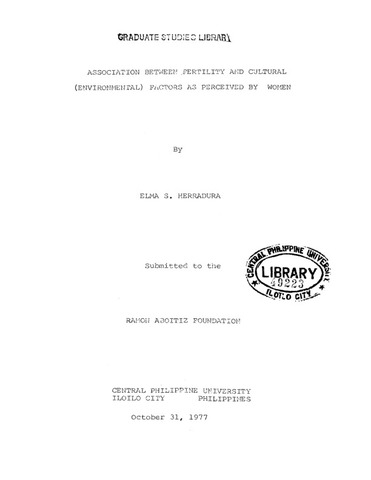| dc.description.abstract | Some cultural factors have been pointed out as being related to the success or failure of family planning programs.
This sub-study was conducted to determine the extent to which fertility is associated with the Women's perceptions of four such cultural factors. With the methods used in the present study, the four cultural factors could not be directly assessed, so, the extent to which these factors exist was to be deduced from the women's perceptions. It is assumed that what is generally perceived by the women is not too far removed from objective reality. The women were asked to react to statements that aimed to get their perceptions of (a) awareness and receptivity of their social environment to birth control beliefs and practices, (b) receptivity of innovations and change, (c) the non-authoritarianism and (d) non-fatalistic tendencies of people around them. These reactions were scored.
The scores which indicate the extent of the environment's awareness of and receptivity to birth control beliefs and practices are henceforth referred to briefly as "birth-control scores." The scores indicating the openness of the environment to innovations and change are referred to as "innovation- change scores." The extent of the non-authoritarianism and non-fatalism of the community, as perceived by the women, is indicated by the "non-authoritarianism scores" and "non-fatalism scores." The assumption is that the higher these scores are, the more favorable the cultural environment is to family planning programs.
Profiles of the respondents
The 460 women-respondents of this study are described in an earlier part, as to their ages, socio-economic status, types of community in which they live, educational attainments, other familial circumstances, and psychological factors other than perceptions. This part of the report will describe the women grouped according to community, age, practice, SES, and educational attainment in regard to their scores in birth control, innovations and change, non-authoritarianism and nonfatalism.
The perceptions, in terms of scores, of the women in the three types of communities will be described first, followed by those of the age groups, of the SES groups, of the "practice"- groups, and the educational-level groups.
Median scores are used in describing the groups formed on the basis of community, age, SES, and practice because the frequency distributions were found to be skewed. The frequency distributions found for the educational—level groups were also skewed, so median scores were also computed for these groups, but in describing the educational-level groups, means are used because the Duncan Multiple Range Test, (a statistical tool applied to means), was employed to determine the differences between the groups.
In the case of the other groups based on community, age, SES, and practice, the significance of the differences between groups was determined with the use of critical ratios, the use of which is convenient when there are only three or four groups being compared. The use of critical ratios was decided against in the comparison of the six educational-level groups.
For the convenience of the reader, both medians and means are reported in the tables, regardless of which statistic was used in the text. | en_US |


